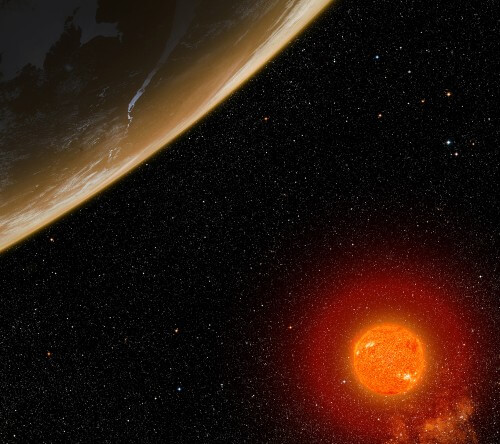Astronomers discovered the first star predicted in the theory under the name of its discoverers in the seventies - Taron-Zhitkov

In a discovery that took decades to make, scientists discovered the first evidence of the existence of a star that was theoretically predicted in 1975 by physicist Kip Thorne and astronomer Anna Zhitkov. Self-Tron-Zhitkov are a cross between an extremely large red giant and a neutron star reminiscent of red supergiants such as Beetlejuice in the Orion group. However, they differ in their chemical signature, which indicates a unique activity inside the star.
It is hypothesized that Taron-Zhitkov objects are formed from contact between two stars - a red supergiant and a neutron star during a supernova explosion in a binary star system where the stars were close together. While the exact mechanism of the object's formation is unknown, theory posits that during the evolution of the interaction between the two stars, the more massive red giant of the two eventually engulfs the neutron star spinning into the red supergiant's core.
While red supergiants generate energy from nuclear fusion within their cores, Tron-Zhitkov bodies are affected by an unusual activity of neutron star ingestion into their cores. The discovery of the Taron-Zhitkov object provides the first evidence for a model that has so far not been discovered by astronomers.
The head of the project, Emily Levesque from the University of Colorado in Boulder, who earlier this year won an award on behalf of the American Astronomical Society, says: The study of these objects is fascinating because they represent a new model of the way a star's interior works. In such cores we discover new ways of creating heavy elements in the universe. You must have heard that everything is made of stellar matter, in these stars we may see a new way of creating part of the matter."
The astronomers made the discovery from the 6.5 meter diameter Clay Telescope in Las Campanes, Chile. They studied the spectrum of light emitted from what appeared to be a red supergiant that showed them what elements were present in the starlight. When the spectrum of one particular star, HV 2112 in the Small Magellanic Cloud was first shown, astronomers were quite surprised by its unusual properties.
When Lavesk and her colleagues closely examined the fine lines of the spectrum they discovered that it contained rubidium, lithium and molybdium. Past studies have shown that in a normal stellar process none of these elements are formed. The high frequency of all three together at temperatures typical of a red supergiant is a unique signature for the Taron-Zhitkov bone.
"I am happy that an observation finally appeared that confirmed our theoretical prediction" said Zhitkov. "Since Thorne and I proposed a model of stars with neutron cores, no one has been able to disprove our work. If the theory is solid, observational confirmation must come sooner or later, so it was just a question of identifying a promising constellation, telescope time and continuing the project."

5 תגובות
Regarding the neutron star residing inside a red giant superstar: isn't it likely that the neutron star will "suck" the material from the red supergiant into it and turn it into crushed matter and neutrons? How long can this phenomenon last before we are left with a neutron star with a full belly? Or with a new black hole under the influence of the added mass? (on a red giant, to remind you)
Regarding the photos - this is a photo of something very bright, and it can probably only be the sun. Note that in some of the images the stars in the background are spread horizontally, as is the circle of the sun. The vertical wings are created due to a well-known phenomenon in CCD sensors called Blooming, in which saturated pixels are filled with electrons due to overexposure, and simply "pour" the electrons to adjacent pixels, which are also filled and pour the excess up and down.
Attached are references to several photographs taken by the Cassini spacecraft orbiting Saturn:
http://saturn.jpl.nasa.gov/multimedia/images/raw/casJPGFullS18/N00049853.jpg
http://saturn.jpl.nasa.gov/multimedia/images/raw/casJPGFullS18/N00049977.jpg
http://saturn.jpl.nasa.gov/multimedia/images/raw/casJPGFullS73/N00190338.jpg
http://saturn.jpl.nasa.gov/multimedia/images/raw/casJPGFullS57/N00150148.jpg
http://saturn.jpl.nasa.gov/multimedia/images/raw/casJPGFullS57/N00150149.jpg
Does anyone have an explanation for the symmetrical formations and please don't come up with tricks like a reflection of what it is or applying color to those formations. Please come with factual and reasoned answers
The greatest astronomical discovery will be an encounter with aliens. To all the skeptics, we are not alone and we are not the crown of creation and we will not be.
I wonder how astronomy can get any weirder and more wonderful than it is now, it seems that there will always be another crazy and interesting discovery.
Definitely a short and interesting article! The next thing will be a hybrid black hole with a wormhole?